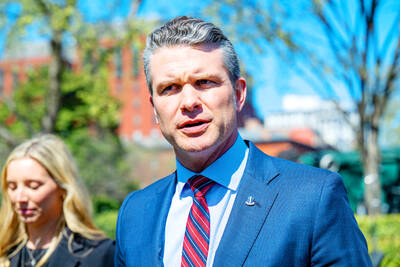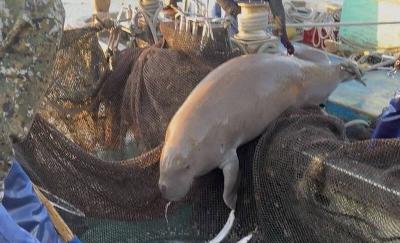The government should consider the impact of offshore wind farms on shipping, fisheries and marine life before allowing energy developers to build more installations, Taiwan People’s Party (TPP) lawmakers and experts said on Wednesday.
The government plans to phase out all nuclear power generation facilities and generate 20 percent of electricity from renewable energy sources by 2025, including 5.7 gigawatts (GW) from offshore wind power. From 2026 to 2035, it plans to source an additional 15GW from offshore wind farms.
Before the government releases new guidelines for phase 3 offshore wind farm development and waterway plans near target farms, it should first review the results of the previous two stages, as only 7.5 percent of the 2025 goal (5.7GW) has been achieved, TPP Legislator Tsai Pi-ru (蔡壁如) told an online news conference.
The phase 3 rules are expected to demarcate “red zones” that prohibit offshore wind farm construction, following controversies about the potential effects of wind farms on fisheries, shipping lanes and marine ecology.
Many controversial issues were discussed only after energy developers had received approvals from the Environmental Protection Administration, TPP caucus whip Chiu Chen-yuan (邱臣遠) said, likening it “to shooting an arrow first before drawing a target.”
The government should look into the needs and activities of shippers, the coast guard, navy and fishers before approving more power projects, he said.
The government’s energy policy is obviously decoupled from its national land planning act, National Taiwan Ocean University emeritus professor Chiau Wen-yan (邱文彥) said.
Chiau, a former Chinese Nationalist Party (KMT) lawmaker, in 2015 proposed a draft bill on the management of territorial waters within 12 nautical miles (22.2km). The bill passed a preliminary review by the legislature’s Internal Administration Committee that year, but has not progressed further.
Chiau said he supports offshore wind farm development, but questions whether it is good to install so many wind turbines in the Taiwan Strait.
Instead of hastening to meet its 2025 energy target, it should slow down and re-evaluate its overall marine territory plans by taking into account different activities in its waters, he said.
Matsu Fish Conservation Union chairman Robin Winkler said that endangered Taiwanese humpback dolphins live in waters 2 to 3 nautical miles (3.7km to 5.6km) off the coast and their habitats might be endangered by offshore wind turbine installations.
A more thorough discussion of offshore development projects is needed, he said.
Last year, only 5.8 percent of the nation’s electricity came from renewable energy sources, while 40.8 percent was from gas-fired units, 36.4 percent from coal-fired sources, 12.7 percent from nuclear energy and the rest from other sources, data on Taiwan Power Co’s Web site shows.
Officials from the Bureau of Energy and the Maritime and Port Bureau who attended the news conference said they would further discuss the demarcation of shipping lanes and how to avoid damaging the habitats of dolphins.

‘DENIAL DEFENSE’: The US would increase its military presence with uncrewed ships, and submarines, while boosting defense in the Indo-Pacific, a Pete Hegseth memo said The US is reorienting its military strategy to focus primarily on deterring a potential Chinese invasion of Taiwan, a memo signed by US Secretary of Defense Pete Hegseth showed. The memo also called on Taiwan to increase its defense spending. The document, known as the “Interim National Defense Strategic Guidance,” was distributed this month and detailed the national defense plans of US President Donald Trump’s administration, an article in the Washington Post said on Saturday. It outlines how the US can prepare for a potential war with China and defend itself from threats in the “near abroad,” including Greenland and the Panama

A wild live dugong was found in Taiwan for the first time in 88 years, after it was accidentally caught by a fisher’s net on Tuesday in Yilan County’s Fenniaolin (粉鳥林). This is the first sighting of the species in Taiwan since 1937, having already been considered “extinct” in the country and considered as “vulnerable” by the International Union for Conservation of Nature. A fisher surnamed Chen (陳) went to Fenniaolin to collect the fish in his netting, but instead caught a 3m long, 500kg dugong. The fisher released the animal back into the wild, not realizing it was an endangered species at

The High Prosecutors’ Office yesterday withdrew an appeal against the acquittal of a former bank manager 22 years after his death, marking Taiwan’s first instance of prosecutors rendering posthumous justice to a wrongfully convicted defendant. Chu Ching-en (諸慶恩) — formerly a manager at the Taipei branch of BNP Paribas — was in 1999 accused by Weng Mao-chung (翁茂鍾), then-president of Chia Her Industrial Co, of forging a request for a fixed deposit of US$10 million by I-Hwa Industrial Co, a subsidiary of Chia Her, which was used as collateral. Chu was ruled not guilty in the first trial, but was found guilty

DEADLOCK: As the commission is unable to forum a quorum to review license renewal applications, the channel operators are not at fault and can air past their license date The National Communications Commission (NCC) yesterday said that the Public Television Service (PTS) and 36 other television and radio broadcasters could continue airing, despite the commission’s inability to meet a quorum to review their license renewal applications. The licenses of PTS and the other channels are set to expire between this month and June. The National Communications Commission Organization Act (國家通訊傳播委員會組織法) stipulates that the commission must meet the mandated quorum of four to hold a valid meeting. The seven-member commission currently has only three commissioners. “We have informed the channel operators of the progress we have made in reviewing their license renewal applications, and